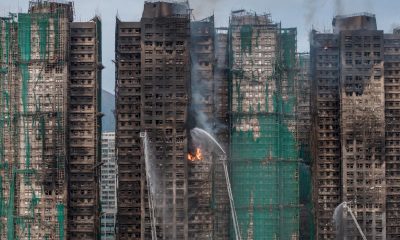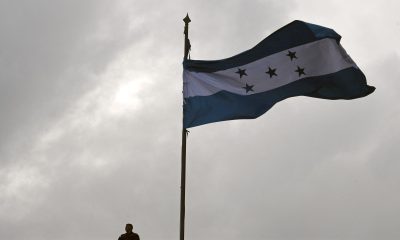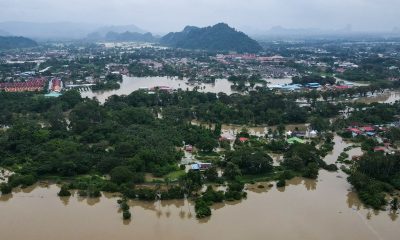International
Volcano refugees start returning to DR Congo from Rwanda

AFP/Editor
More than a thousand refugees left a camp in Rwanda to return to the Democratic of Congo on Saturday, officials said, after escaping over the border fearing Mount Nyiragongo could erupt again.
Africa’s most active volcano roared back to life a week ago, sending terrified people in the nearby city of Goma running for their lives as rivers of lava destroyed homes and claimed nearly three dozen lives.
The eruption stopped, but warnings in recent days that it could blow again sent nearly 400,000 people rushing from Goma, with thousands crossing into Rwanda at a nearby border point.
Around 3,000 people sought refuge at a temporary camp in Rugerero, about ten kilometres (six miles) from the border.
But on Saturday an estimated 1,200 had left for Goma, a Rwanda government official at Rugerero told AFP on condition of anonymity. Military trucks were seen transporting refugees to the border.
William Byukusenge, a construction worker, said he felt the danger had passed.
“My house is in good shape, I have a wife and two kids. If it erupts again, we will come back to Rwanda,” the 21-year-old Congolese evacuee told AFP.
But another evacuee, Marie Claire Uwineza, said she had nowhere left to go.
“My house was burned, and I have nothing left,” said the 39-year-old, who fled with two of her children.
She was being sent to another camp at Busasamana, around 35 kilometres from the border, along with other evacuees unwilling or unable to return home yet.
At the camp, aid workers hastily erected tents and toilet facilities to meet growing demand.
Boubacar Bamba, the UN refugee agency’s deputy representative for operations in Rwanda, told AFP the camp’s population had swollen in recent days from around 800 evacuees to closer to 2000.
“There is no time to plan. We plan and execute at the same time, because we are caught short by events,” he said.
“This site is designed for a maximum of 3,000 people. The likelihood of receiving more people depends on the activity of the volcano, we do not control that. We are preparing for all eventualities, even if our resources are not sufficient,” he added.
DR Congo’s government said Saturday that the eruption of a second, nearby volcano it had announced hours earlier was a “false alarm”.
Nearly 3,500 metres (11,500 feet) high, Nyiragongo straddles the East African Rift tectonic divide.
Its last major eruption, in 2002, claimed around 100 lives and the deadliest eruption on record killed more than 600 people in 1977.
Volcanologists say the worst-case scenario is an eruption under nearby Lake Kivu — a so-called “limnic eruption” when lava combines with a deep lake and spews out lethal, suffocating gas across a potentially large area.
International
El Chapo’s son Joaquín Guzmán López pleads guilty to U.S. drug trafficking charges

Joaquín Guzmán López, one of the sons of notorious Mexican drug lord Joaquín “El Chapo” Guzmán, pleaded guilty on Monday to drug trafficking charges in a U.S. court, months after his brother Ovidio reached a similar plea agreement, according to local media reports.
The defendant appeared before a federal court in Chicago early Monday afternoon and changed his previous plea in the case, the Chicago Tribune reported. U.S. authorities accuse him of forming, together with his three brothers, the cartel faction known as “Los Chapitos.”
The group is believed to have continued the operations of El Chapo, who has been serving a life sentence in the United States since 2019.
Guzmán López, 39, was arrested after landing in Texas in a small aircraft alongside cartel co-founder Ismael “El Mayo” Zambada.
International
Venezuela authorizes return flights as U.S. continues deportations amid rising tensions

The arrival of U.S. aircraft carrying undocumented Venezuelan migrants continued regularly despite rising tensions between Washington and Caracas over President Donald Trump’s military deployment in the Caribbean.
Trump maintains that the deployment is part of an anti-narcotics operation, while Venezuelan President Nicolás Maduro insists the true objective is to remove him from power and seize the nation’s oil resources.
Venezuela’s aviation authority has “received a request from the United States government to resume repatriation flights for Venezuelan migrants from that country to Venezuela,” the Ministry of Transportation said in a statement .
“Under the instructions of President Nicolás Maduro, authorization has been granted for these aircraft to enter our airspace,” it added.
Caracas will permit two Eastern Airlines flights to land on Wednesday and Friday.
Migration remains one of the Trump administration’s flagship issues. On Monday, the U.S. president held a meeting with his National Security Council to discuss the situation in Venezuela, a day after confirming he had spoken with Maduro by phone, without offering further details.
According to the Venezuelan government, roughly 75 deportation flights have been carried out this year, returning at least 13,956 Venezuelans from the United States.
International
20,000 rounds stolen from german army after driver leaves cargo unattended

The German army confirmed the theft of a shipment of ammunition that occurred a week ago while it was being transported by a civilian delivery driver, a military spokesperson told AFP, confirming earlier media reports.
According to Der Spiegel and the regional broadcaster MDR, around 20,000 rounds of ammunition were stolen from an unguarded parking lot near Magdeburg, in eastern Germany, while the driver was asleep in a nearby hotel. No information has been released regarding the identity of the suspects, and the military declined to specify the exact type or amount of ammunition taken.
Authorities have also not indicated how the perpetrators knew the cargo would be left unattended.
“The theft was discovered upon delivery at the barracks,” the German army spokesperson said.
A police spokeswoman confirmed to AFP that an investigation has been opened but refused to provide further details “for tactical reasons.”
Sources close to the German military, cited by Der Spiegel, believe it is unlikely the theft was a coincidence. They suspect the thieves waited for the driver to stop for the night before striking.
Der Spiegel also reported that the Defense Ministry normally requires two drivers for this type of transport to ensure the cargo is constantly monitored. However, in this case only one driver was assigned, meaning the civilian transport company failed to comply with the security protocols.
-

 Central America4 days ago
Central America4 days agoTrump Pardons Former Honduran President Hernández and Warns of Aid Cuts Ahead of Election
-

 Central America2 days ago
Central America2 days agoHonduras Extends Voting by One Hour Amid High Turnout, CNE Announces
-

 International1 day ago
International1 day agoHong Kong police arrest 13 over deadly high-rise fire that killed 151
-

 Central America3 days ago
Central America3 days agoHonduras’ China–Taiwan Future Hinges on Sunday’s Presidential Election
-

 International4 days ago
International4 days agoMeta Says Russia Seeks to Ban WhatsApp for Defending Secure Communication
-

 International1 day ago
International1 day agoSri Lanka and Indonesia deploy military as deadly asian floods kill over 1,000
-

 International1 day ago
International1 day agoTrump says asylum decision freeze will remain in place “for a long time”
-

 International1 day ago
International1 day agoChile enters runoff campaign with Kast leading and Jara seeking a last-minute comeback
-

 International8 hours ago
International8 hours ago20,000 rounds stolen from german army after driver leaves cargo unattended
-

 International8 hours ago
International8 hours agoVenezuela authorizes return flights as U.S. continues deportations amid rising tensions
-

 International9 hours ago
International9 hours agoTrump convenes National Security Council as U.S.–Venezuela tensions intensify
-

 International8 hours ago
International8 hours agoEl Chapo’s son Joaquín Guzmán López pleads guilty to U.S. drug trafficking charges






























